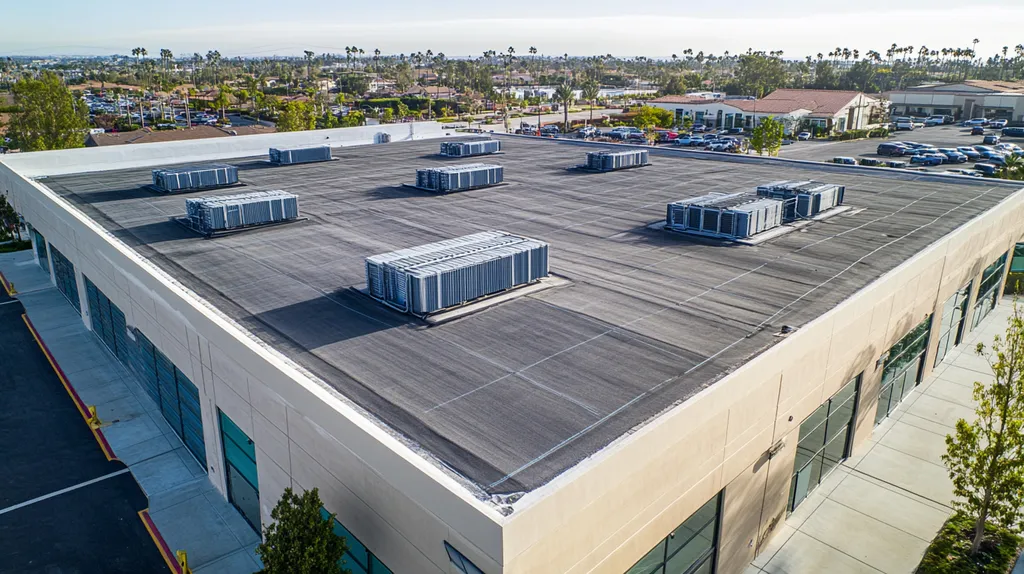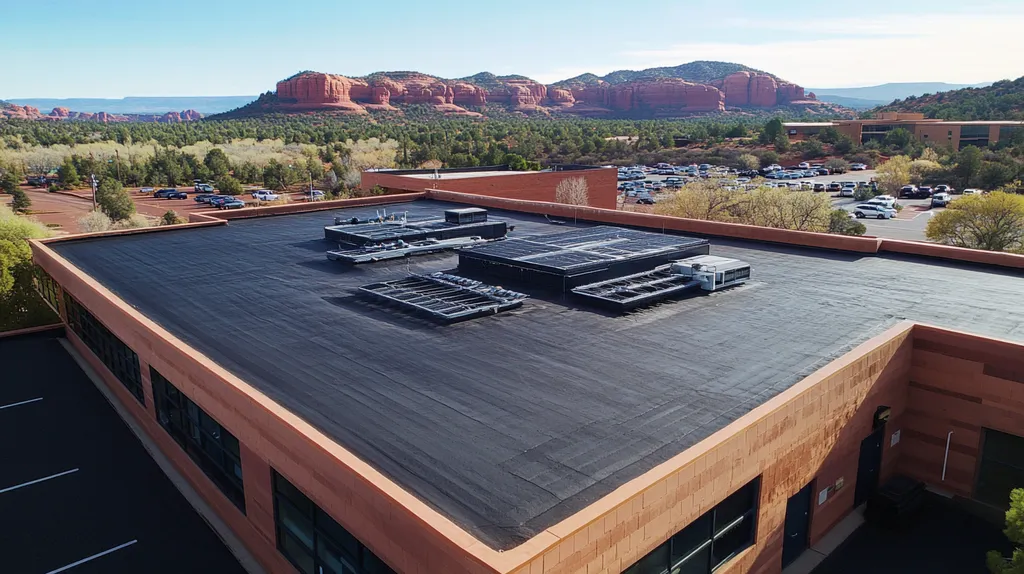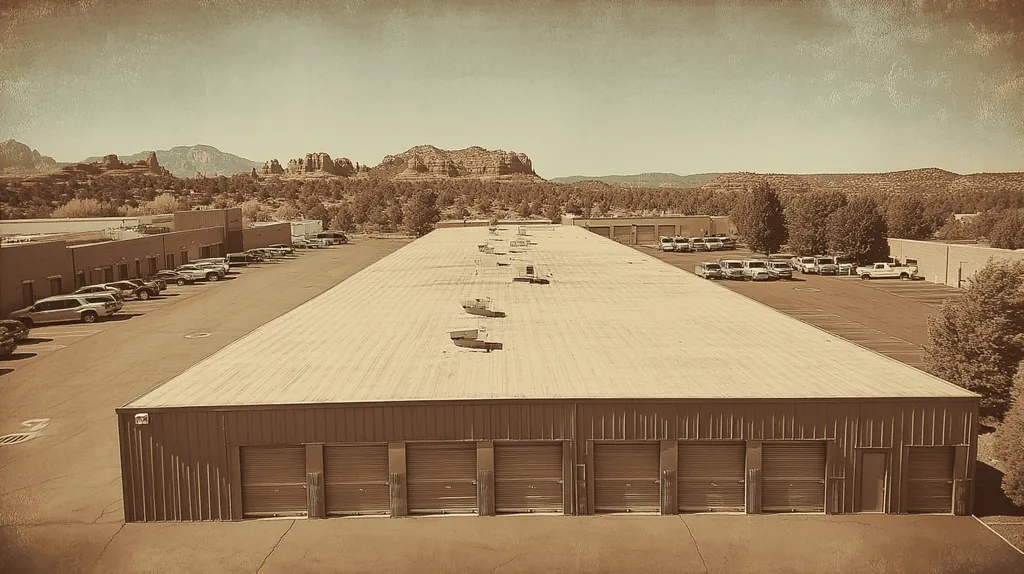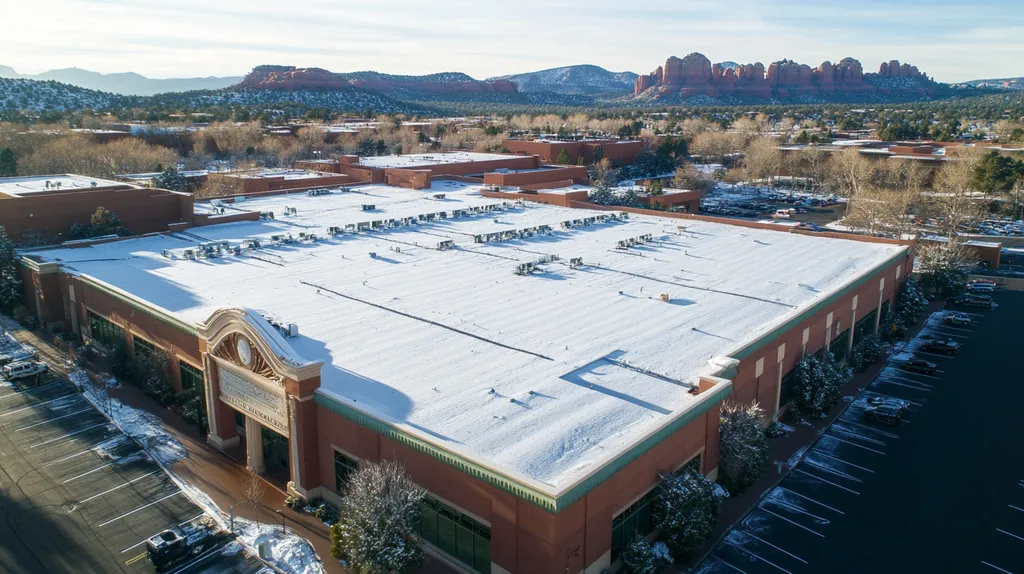In today’s industrial roofing landscape, equipment selection can mean the difference between a coating that lasts 20 years and one that fails within months. Studies show that improper application tools and techniques account for over 60% of premature roof coating failures, resulting in millions in damages annually.
From advanced spraying systems to precision measurement devices, the right equipment arsenal is crucial for successful industrial roof coating projects. Property owners and facility managers must navigate an ever-evolving marketplace of tools and technologies.
This comprehensive guide examines the essential equipment needed for industrial roof coating applications, exploring everything from fundamental components to cutting-edge innovations that are transforming the industry.
SECTION 1: FUNDAMENTAL CONCEPTS
Understanding industrial roof coatings is essential for property owners and facility managers looking to safeguard their investments. These advanced coatings not only prolong the life of roofs but also significantly cut down on maintenance expenses. For instance, studies show that a carefully selected coating can reduce roof temperatures by up to 80%, translating into notable energy savings. In this section, we will delve into the various types of coatings available, their many benefits and applications, and how to ensure compatibility with existing roofing materials.
Types of Industrial Roof Coatings
Industrial roof coatings come in a range of formulations tailored to meet specific demands and environmental conditions. Among the most common types are silicone, acrylic, and polyurethane coatings. Silicone coatings are favored for their exceptional waterproofing capabilities and UV resistance, making them particularly suitable for flat roofs.
Acrylic coatings shine in cooler climates due to their excellent temperature tolerance, providing versatility for both new and existing roofs. Lastly, polyurethane coatings are engineered for durability, offering resistance to foot traffic and chemical spills, which is crucial in industrial settings.
Each type presents distinct characteristics that affect their performance, lifespan, and overall cost. The key to effective application lies in selecting the right coating based on the building’s unique requirements, the local climate, and the type of roofing material in use.
Being aware of these diverse options empowers property owners to make informed choices aligned with their operational needs.
Benefits and Applications
Roof coatings bring a variety of benefits that surpass mere aesthetics; they are fundamental in enhancing a roof’s functional performance. One of the most important advantages is energy efficiency, as reflective coatings can significantly reduce heat absorption, leading to lower cooling costs during the sweltering summer months.
In addition to energy savings, roof coatings provide robust protection against environmental challenges, increasing the roof’s resistance to leaks and damage from rain, wind, and UV rays. Many of these coatings also feature self-cleaning properties, which help minimize maintenance efforts and costs over time.
The versatility of industrial roof coatings is evident across numerous applications, from warehouses to manufacturing facilities. Buildings situated in extreme environmental conditions often experience remarkable durability and performance improvements when enhanced with high-quality coatings.
Ultimately, strategic deployment of roof coatings can boost both the lifespan and the efficiency of industrial roofing systems.
Compatibility with Roofing Materials
Ensuring compatibility between roof coatings and existing materials is crucial for effective application and longevity. Different roofing substrates, such as metal, EPDM, or modified bitumen, react differently to various coatings. A silicone coating, for example, may adhere well to a metal roof but could fail to perform adequately on asphalt surfaces.
Consequently, assessing the current roofing material is pivotal before choosing a coating. Utilizing incompatible products can lead to issues such as delamination and premature roof failure, resulting in costly and disruptive repairs.
Moreover, proper surface preparation cannot be overlooked. Thorough cleaning and priming are essential steps to enhance adhesion and ensure that the coating performs as intended.
In the end, understanding compatibility can simplify the decision-making process, leading to successful roof coating applications that stand the test of time.
SECTION 2: SYSTEM COMPONENTS
The choice of equipment can significantly influence the success of an industrial roof coating project. Using the wrong tools can result in uneven application, wasted resources, and costly repairs. Studies indicate that improper application methods can reduce a roof’s lifespan by as much as 30%. Therefore, understanding critical equipment components is paramount for building owners and facility managers who want reliable and long-lasting roofing solutions.
Roof Coating Sprayers and Equipment
Choosing the right sprayer is essential for effectively applying industrial roof coatings. High-pressure airless sprayers are often the best option for larger roofs. They provide consistent coverage and can handle thicker materials, ensuring an even application that minimizes the risk of pooling or missed areas.
For smaller projects, handheld sprayers or rollers may offer the flexibility needed for quick touch-ups and detailed work. Each sprayer type has its distinct advantages tailored to specific project demands, making careful assessment crucial before making a purchase.
Investing in high-quality sprayers can also enhance material efficiency. For instance, advanced models with built-in pressure control help minimize overspray, which can significantly reduce unnecessary waste and improve budget efficiency.
Understanding sprayer options is key to achieving better application practices and extending the life of roof coatings. This knowledge is invaluable for reducing future maintenance costs and reinforcing a roofing investment.
Coating Thickness Gauges and Tools
Accurate measurement of coating thickness is vital for effective application. Coating thickness gauges help determine if the applied layers meet manufacturer specifications—an oversight that can lead to premature failure if ignored.
Magnetic gauges are best suited for ferrous metal substrates, while ultrasonic gauges can efficiently measure thickness across various surfaces, including concrete. Selecting the right tool for the job is critical for ensuring accuracy in assessments.
Conducting consistent measurements helps identify areas that may require additional coating, thus mitigating weak spots on the roof. Implementing straightforward testing techniques can prevent costly mistakes and enhance the overall effectiveness of the roofing system.
Facility managers should prioritize regular thickness checks to maintain coating integrity. Upholding the right thickness directly contributes to energy savings and significantly boosts the durability of roofing systems.
Moisture Detection and Scanning Devices
Moisture can severely compromise even the most durable roof coatings, making early detection essential. Advanced moisture detection devices are invaluable for identifying trapped moisture before it escalates into major issues. Recognizing the impact of moisture-related problems is crucial since they can lead to mold growth and expensive repairs.
Infrared scanners are highly effective for locating moisture beneath roofing layers, facilitating non-invasive assessments that highlight areas needing immediate attention. By addressing concerns early, property owners can save considerable resources in the long run.
Resistance moisture meters offer another reliable method for accurately gauging moisture levels by measuring electrical resistance. These devices pinpoint problem areas, allowing for timely repairs and improved coating applications.
Integrating moisture detection as a standard practice is essential for long-term roof performance. Investing in these technologies promotes proactive maintenance, minimizes overall roofing costs, and safeguards property investments.
SECTION 3: IMPLEMENTATION METHODS
Implementing industrial roof coatings effectively is vital for extending the life of roofs and enhancing overall energy efficiency. Studies show that roofs lacking proper preparation are susceptible to early failures, which can lead to substantial repair costs for property owners. By mastering the implementation methods, stakeholders can not only ensure a successful application but also protect their investments. This section will explore the critical steps of preparation and surface cleaning, application techniques, and essential safety protocols.
Preparation and Surface Cleaning
The cornerstone of any successful roof coating project lies in meticulous preparation. This foundational step is essential to achieve maximum adhesion and optimal performance of the coating. A clean and well-prepared surface allows the coating to bond effectively, drastically reducing the chance of peeling or flaking down the line.
Surface cleaning involves removing dirt, debris, and any existing coatings. Pressure washing often serves as the first line of attack for achieving a spotless substrate, but care must be taken to also address any oil or grease residues. Failing to do so can result in the new coating’s failure, leading to needless expenses.
Additionally, a comprehensive inspection of the roof’s current condition is crucial prior to surface preparation. Identifying any damages or weak points enables property owners to rectify these issues before applying the coating. This may involve repairing seams, flashings, or addressing areas prone to ponding water.
Ultimately, thorough preparation is what paves the way for durability and efficacy. Neglecting this critical stage can jeopardize the entire project and waste investment in high-quality materials.
Application Techniques and Best Practices
Once the preparation phase is executed, selecting the right application technique becomes critical. Proper application not only ensures even coverage but also maximizes the performance of the coating system. Airless spray systems are frequently chosen for their efficiency and ability to apply uniform layers.
For smaller or intricate areas, rollers and brushes remain valuable alternatives. While airless systems can expedite the process on large surfaces, rollers allow for greater control in detailed applications, making the choice dependent on the substrate’s texture.
Adhering to the manufacturer’s guidelines for temperature and humidity is vital for application success. Each product has specific requirements that must be followed to achieve the intended lifespan and effectiveness of the coating.
Timing the application is equally important. By avoiding windy or rainy conditions, property owners can prevent complications in drying and ensure quality results. By following best practices in application, the overall efficacy and longevity of the roof coating can be significantly enhanced.
Safety Protocols and Regulations
Establishing safety protocols during roof coating projects is essential for the protection of workers and property. Compliance with Occupational Safety and Health Administration (OSHA) regulations is necessary, as these guidelines serve to minimize workplace hazards and ensure a safe environment.
Personnel should be equipped with Personal Protective Equipment (PPE) such as respirators, gloves, and safety goggles to guard against harmful fumes and materials. Ensuring that all team members receive proper training in application techniques is crucial for reducing accidents on the job.
Employing fall protection systems is another critical safety measure when working at heights. Harnesses, guardrails, and safety nets act as safeguards against falls, one of the predominant risks in the roofing industry.
Finally, a comprehensive safety plan should be communicated to all members of the crew. By prioritizing safety and adhering to regulatory standards, property owners can mitigate risks and ensure that their roofing projects are not only successful but also safe for everyone involved.
SECTION 4: MAINTENANCE REQUIREMENTS
The care and upkeep of industrial roof coatings are not optional; they are essential to maintaining roof integrity and extending lifespan. Research reveals that neglecting routine maintenance can shorten a roof’s longevity by an astounding 50%. Proper maintenance preserves the roof’s structure and shields it from costly repairs, making regular inspections, timely repairs, and structured preventative schedules critical components of any maintenance strategy.
Regular Inspection and Monitoring
Regular inspections serve as the first line of defense against roofing issues. Pairing biannual inspections with a trained technician ensures that cracks, blisters, and moisture build-up are caught before they escalate. It’s important to utilize experienced professionals who can assess the roof’s condition accurately, spotting visible deterioration before it worsens.
Integrating advanced monitoring technologies such as infrared scanning can add an extra layer of assurance. This method detects trapped moisture beneath the coating layer, revealing hidden problems that typical inspections might miss. Combining visual and technological assessments creates a holistic maintenance strategy.
Documentation during inspections is key. Maintaining a detailed log allows property managers to track recurring issues and the roof’s overall health, informing future repair or replacement decisions. Regular updates can be instrumental in budgeting for maintenance needs.
Finally, aligning inspections with manufacturer guidelines is crucial. Doing so not only protects warranties but ensures compliance with product specifications, which is vital if unexpected issues arise.
Repair and Touch-Up Procedures
Prompt repairs are essential in maintaining the integrity of industrial roofs. When damage is detected during inspections, immediate action is critical to avert further complications. For instance, a minor blister that goes unchecked can quickly escalate into a significant leak, causing extensive interior damage.
Incorporating touch-up procedures means addressing visible damage while also safeguarding against potential vulnerabilities. Using high-quality patch materials that blend seamlessly with the existing coating enhances both durability and aesthetics. Proper application techniques, such as feathering edges, will result in an unobtrusive repair.
Facility managers should develop a standardized repair process. This may involve checklists for common issues and clear documentation of corrective actions taken. A methodical approach will streamline maintenance and improve team communication.
Looking ahead, incorporating seasonal touch-ups or additional protective coatings can significantly prolong roof life. Continued investment in timely repairs reflects a commitment to asset preservation while minimizing long-term costs.
Preventative Maintenance Schedules
Preventative maintenance plays a pivotal role in roofing longevity. Establishing a structured maintenance schedule, informed by manufacturer recommendations and specific environmental conditions, maximizes the roof’s performance. Roofs exposed to high levels of UV radiation may warrant more frequent inspections and maintenance treatments.
A sensible preventative maintenance strategy includes regular checks for debris, water accumulation, and signs of UV damage. Addressing these potential risks proactively can prevent serious issues down the line.
Additionally, site-specific factors, such as proximity to trees or industrial emissions, should inform tailored maintenance routines. Customizing schedules to address unique challenges effectively enhances roofing resilience.
Budgeting for preventative maintenance is equally important. Setting aside financial reserves for routine upkeep helps circumvent unexpected expenses, ensuring ongoing protection for the roof remains a top priority.
SECTION 5: PERFORMANCE METRICS
In the competitive landscape of industrial roofing, understanding performance metrics is not just an option—it’s a necessity. Poorly applied roof coatings can result in substantial building damage and waste precious energy resources. Research indicates that as much as 30% of cooling expenses in commercial spaces can stem from inadequate roof performance. For property owners and facility managers, familiarizing themselves with vital performance indicators is essential to safeguarding their investments and ensuring lasting durability. This section will address how to measure coating thickness and adhesion, evaluate UV resistance and durability, and assess energy efficiency and cost savings.
Measuring Coating Thickness and Adhesion
Coating thickness and adhesion are crucial indicators of a roof’s performance. An insufficient coating can compromise the roof’s ability to withstand harsh weather, leading to premature failures. Implementing wet film thickness tests during application is an effective way to ensure that the coating aligns with the manufacturer’s specifications.
After application, it’s vital to assess adhesion strength using methods like the pull-off test. This ensures that the coating bonds effectively with the substrate, protecting against delamination over time. Regular inspections after installation can identify any potential issues early on.
Precise measurements are also instrumental for warranty claims, guaranteeing that property owners benefit from their investments. By maintaining detailed records of these performance metrics, facility managers can optimize their long-term maintenance strategies.
Ultimately, consistent measurement of coating thickness and adhesion helps protect against expensive repairs and extends the life of the roofing system.
Evaluating UV Resistance and Durability
UV resistance plays a pivotal role in determining a coating’s lifespan, especially in regions with intense sun exposure. Coatings that offer superior UV protection preserve the integrity of the underlying substrate, preventing degradation and thermal cycling issues.
Durability can be assessed through standard tests such as accelerated weathering, which mimic long-term exposure to UV rays and moisture. These tests evaluate how well the coating resists cracking, peeling, and fading over time.
The data collected from these evaluations provides essential insights for property owners, enabling informed decisions on coatings that will endure the elements while maintaining their visual appeal. Investing in high-quality coatings ultimately leads to reduced maintenance expenses.
By evaluating UV resistance and durability, property owners can ensure their roofs perform optimally for years to come, enhancing the overall value of their buildings.
Assessing Energy Efficiency and Cost Savings
Energy efficiency is a vital metric that directly influences operational expenses. Reflective coatings can significantly decrease heat absorption, with potential air conditioning savings reaching up to 30%. This results not only in financial savings but also supports broader sustainability goals.
Property owners should evaluate the return on investment (ROI) for energy-efficient coatings. Utilizing energy modeling software can help project long-term energy savings, underscoring the financial benefits of upgrading roofing materials.
Moreover, these advanced coatings can earn buildings energy efficiency certifications, enhancing their market appeal. Case studies consistently show that updated coatings lead to notable cost reductions and improved indoor environments.
Ultimately, assessing energy efficiency is not merely about cutting costs—it’s about bolstering the overall performance and marketability of the building.
SECTION 5: PERFORMANCE METRICS
In the world of industrial roofing, the stakes couldn’t be higher. Poorly executed roof coatings can lead to severe damage and excessive energy costs. Research shows that as much as 30% of cooling expenses in commercial buildings can be linked to subpar roof performance. It’s critical for property owners and facility managers to understand performance metrics to protect their investments and ensure longevity. This section will walk through measuring coating thickness and adhesion, evaluating UV resistance and durability, and assessing energy efficiency and cost savings.
Measuring Coating Thickness and Adhesion
Coating thickness and adhesion are crucial indicators of a roof’s overall performance. An inadequate coating compromises the roof’s resilience against the elements, setting the stage for early failures. Conducting wet film thickness tests during application ensures that the coating meets manufacturer specifications for optimal protection.
Furthermore, assessing adhesion strength after application using techniques like the pull-off test is essential. This guarantees a strong bond between the coating and the substrate, preventing delamination as time passes. Routine inspections post-installation can help detect any issues before they escalate.
Accurate measurements play a vital role in warranty claims, ensuring property owners reap the rewards of their investments. By maintaining meticulous records of these performance metrics, facility managers can enhance their long-term maintenance strategies.
In the end, consistently measuring coating thickness and adhesion safeguards against costly repairs and extends the roofing system’s lifespan.
Evaluating UV Resistance and Durability
UV resistance is instrumental in determining a coating’s longevity, especially in sun-soaked regions. Coatings that boast superior UV protection help preserve the substrate underneath, mitigating risks of degradation and thermal cycling challenges.
The durability of a coating can be evaluated through standardized tests such as accelerated weathering. This method simulates prolonged exposure to UV rays and moisture, assessing the coating’s ability to resist cracking, peeling, and fading over time.
Data gathered from these evaluations equips property owners with the insights necessary to select coatings that will endure environmental challenges while maintaining their visual appeal. Investing in high-quality coatings ultimately curtails maintenance costs down the road.
By evaluating UV resistance and durability, property owners ensure roof performance remains strong while bolstering their building’s value in a competitive market.
Assessing Energy Efficiency and Cost Savings
Energy efficiency is a crucial metric that significantly affects operational expenses. Reflective coatings can drastically reduce heat absorption, leading to potential air conditioning savings of up to 30%. This not only yields financial benefits but also aligns with sustainability goals.
Property owners should analyze the potential return on investment (ROI) linked with energy-efficient coatings. Using energy modeling software can help project future energy savings, fortifying the case for upgrading roofing materials.
Moreover, these advanced coatings can make buildings eligible for energy efficiency certifications, enhancing market appeal. Case studies consistently indicate that improved coatings result in notable cost savings and better indoor environments.
Ultimately, assessing energy efficiency goes beyond mere cost-cutting—it’s about boosting overall performance and the marketability of the property.
Looking Ahead
The industrial roofing sector stands at a critical junction, where equipment selection can make the difference between a 20-year coating lifespan and catastrophic failure within months.
Advanced spraying systems, precision measurement tools, and cutting-edge moisture detection devices have revolutionized how we approach roof coating applications.
Studies show that facilities implementing comprehensive equipment strategies and following proper protocols reduce their maintenance costs by up to 40% while extending roof life by decades.
As environmental pressures mount and energy costs rise, the stakes for proper equipment selection and implementation have never been higher.
The future of industrial roofing lies not just in advanced coating materials, but in the sophisticated tools and technologies that ensure their optimal performance.
FREQUENTLY ASKED QUESTIONS
Q. What are industrial roof coatings and their benefits?
A. Industrial roof coatings enhance a roof’s lifespan and energy efficiency. They reduce maintenance costs while protecting against environmental elements like UV rays and moisture. By opting for the right coating, property owners safeguard their investments and cut down energy expenses.
Q. How do I choose equipment for commercial roof coating?
A. Selecting proper equipment is vital to ensure even application of the coating. High-pressure airless sprayers work well for larger areas, while handheld models are great for detailed work. Investing in quality tools guarantees efficient material use and fewer application errors.
Q. What is essential in preparing surfaces for industrial roof coatings?
A. Proper surface preparation is crucial for successful application. This entails cleaning to remove debris and addressing any existing damages. Thorough inspections can help identify weak spots before applying the coating, paving the way for optimal adhesion.
Q. How often should I inspect my industrial roof?
A. Regular inspections, ideally biannually, are essential for spotting visible issues early. Engaging trained technicians can ensure that everything from small cracks to moisture buildup are identified before they escalate into costly repairs. Keeping records of inspections aids in long-term maintenance planning.
Q. What are the key performance metrics for roof coatings?
A. Key performance metrics include measuring coating thickness and adhesion, as well as assessing UV resistance and energy efficiency. Regular monitoring of these factors can help property owners ensure their roofing systems perform optimally and remain durable over time.
Q. What are common maintenance practices for industrial roofs?
A. Regular inspections, prompt repairs, and establishing preventative maintenance schedules are crucial. Touching up minor damages immediately helps prevent larger problems, while seasonal checks ensure that the roof remains in peak condition and protected from environmental stressors.
Q. How can I improve energy efficiency with roof coatings?
A. Opting for reflective coatings can significantly reduce heat absorption and cooling costs. Assessing the return on investment through energy modeling can clarify long-term savings, while maintaining a clean and well-insulated roof enhances overall energy efficiency.










